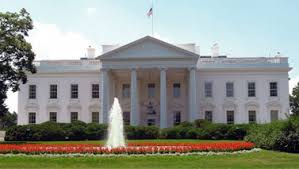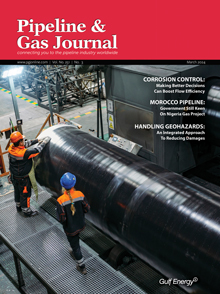January 2017, Vol. 244, No. 1
Government
Government

BLM Rule Could Stimulate Gathering Line Construction
The final rule requiring oil and gas exploration companies on federal lands to capture gas instead of flaring may be a boon to the pipeline construction industry but a potential bust to well developers.
It is not often that a federal regulatory dictate is good for one section of the oil and gas industry but bad for another. But the Bureau of Land Management (BLM), which is part of the Department of Interior, manages to create that divergence with its November decision, affecting nearly 100,000 federal onshore oil and gas wells, which account for 11% of the nation’s natural gas supply and 5% of its oil.
Producers will have to connect many, but not all wells, to pipeline gathering systems to collect the new gas. Much of that infrastructure is not in place and would cost producers millions to build. However, Dan Naatz, senior vice president of government relations and political affairs at Independent Petroleum Association of America (IPAA), said, “a lack of infrastructure and gathering lines to collect gas at the wellhead makes it difficult for producers to safely transport our product to market.”
In its January Regulatory Impact Analysis, the BLM does not include any amounts related to pipeline construction, and has not estimated the miles of pipeline that may be needed to meet the connection requirements.
There is a concern that producers in areas such as North Dakota and New Mexico, where the heaviest exploration on federal lands is being done, may opt to close smaller well sites rather than spend what it costs to connect them to existing or prospective gathering systems.
“The new rule has a potential of closing in natural gas development on federal lands which is not good for producers or for GPA Midstream members,” said Matthew Hite, vice president of Government Affairs, GPA Midstream Association. “I don’t think this rule will lead to an increase in gathering line construction. In the cases where venting or flaring happens, the reasons are usually because lengthy permitting delays or cost-prohibitive economics that have prohibited the installation of gathering lines.”
The cost of new infrastructure, along with arguments about regulatory overreach and new royalty payments, have driven the Western Energy Alliance and the IPAA to file a lawsuit against the BLM, calling the final rule a broad new air quality regime that goes beyond authority granted by Congress.
“The BLM’s rush to regulate something already being regulated at the state and federal level is an example of poor government policy and a left hand not knowing what the right hand is doing,” said American Petroleum Institute director of upstream and industry operations Erik Milito. “BLM’s new regulations are unnecessary, redundant, technically flawed and could stifle the innovations that have led to our nation’s environmental successes.”
The BLM rejects that, saying it has carefully considered and minimized potential overlaps with other federal, state and tribal regulations. The rule includes a provision that authorizes the BLM to grant variances from particular BLM requirements. But the agency declared, “Neither EPA nor state and tribal requirements obviate the need for this rule.”
Republicans in Congress will make every attempt to eliminate the new rule. “This purely political move by the Obama administration is a last-ditch effort to save the president’s crumbling climate legacy,” said Sen. Jim Inhofe (R-OK), chairman of the Senate Environment and Public Works Committee. “The BLM’s rule on methane and the oil and gas industry is unnecessary and duplicative. Congress has many tools with which to rescind this rule, and I look forward to working with the incoming Trump administration to ensure economic expansion prevails over misguided bureaucratic interference.”
The new BLM regulations replace those instituted in 1979. The updates are based on recommendations from the Office of the Inspector General of the Department of the Interior (OIG) and the Government Accountability Office (GAO). The rule is called “Waste Prevention, Production Subject to Royalties, and Resource Conservation” and is to take effect Jan. 17.
The final rule requires operators to evaluate opportunities for gas capture and prepare a waste minimization plan prior to drilling of a development oil well. The plan must be submitted with an application for permit to drill (APD) and must be shared with midstream gas capture companies to allow timely pipeline development.
The final rule made five significant modifications from the proposed rule in an attempt to mollify industry critics. It uses specified capture targets, rather than requiring that operators capture 100% of their associated gas above fixed volumetric limits as initially proposed, in response to comments indicating that, in some states (notably North Dakota and New Mexico), gas volumes are so high and the availability of capture infrastructure so variable that it is extremely difficult to identify a fixed volumetric limit on flaring that would both be achievable and also provide meaningful reductions in all states.
The ability to profit from captured gas – the BLM argues companies can sell the gas and make a net profit – depends on the availability of pipeline gathering capacity. The agency’s cost/benefit analysis found that benefits would be $209-403 million per year based on gas sold and methane taken out of the environment, which is to say its “environmental non-monetary” benefit. The costs would range between $110-279 million per year in each of the next 10 years.
But shortcomings in the pipeline infrastructure may make it difficult to achieve the new sales cranked into the benefit numbers. Numerous companies pointed out the impediments to getting approval of new pipelines built in rights-of-ways (ROWs). The BLM admitted in the final rule that processing time for ROW applications “can sometimes be an issue, particularly in a handful of offices where staff retention has been difficult the past few years.”
It went on to argue processing time is not the primary cause of the large volume of current flaring. BLM data indicate many applications to flare gas come from wells already connected to pipeline infrastructure, or for which operators are not seeking ROWs to build new pipelines. For instance, in Dickinson, ND large volumes of gas are flared from over 1,700 federal and Native American oil wells, yet the local BLM field office has just four ROW applications pending.
While there may be some difference of opinion on whether ROW applications are being processed quickly enough, there is no doubt the cost to build new gathering systems is substantial. Scott Kidwell, vice president of Government and Public Affairs, for Concho Resources, which does substantial federal oil and gas exploration and production in the Permian Basin of New Mexico, said, “If Concho were to construct and install 1 mile of a 4-inch gas line, it would cost Concho approximately $220,000, plus the cost associated with procuring and maintaining the right-of-way.
“An operator of a low-volume oil well that is required to capture the associated gas by constructing and installing a gas line would likely be forced to shut-in or plug the well due to the prohibitive costs associated with procuring, constructing, installing and maintaining the gas line and associated right-of-way,” he said.





Comments